HISTORY BEHIND THE SCENE What’s the real story behind that historical scene from your favorite TV show or feature film? A semi-regular feature on the Bowery Boys blog, we will be reviving this series as we follow along with TNT’s limited series The Alienist. Look for other articles here about other historically themed television shows (Mad Men, The Knick, The Deuce, Boardwalk Empire and Copper). And follow along with the Bowery Boys on Twitter at @boweryboys for more historical context of your favorite shows.
Public bathhouses were an integral component of tenement districts in late 19th and early 20th century New York City. Running water was uncommon in the poorest areas of the city, and when it was available, rusty, filthy pipes ensured that its consumption would be an unpleasant and often unhealthy experience.
And of course there was often very little available for bathing. As a result, life was so very fragrant back then.
Temporary outdoor baths sprang up around the city during the summer such as this one off Fifth Street on the East River in 1870.
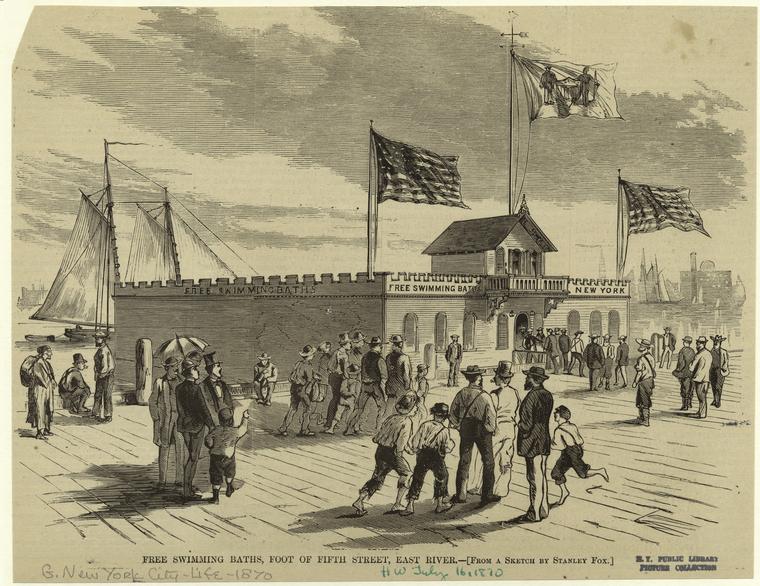
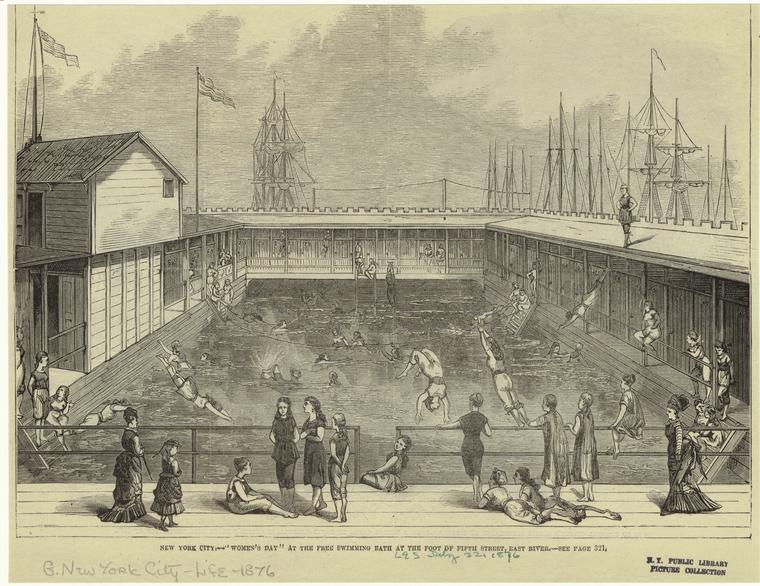
From Harper’s Weekly, August 20, 1870. “We give on this page an illustration of the swimming bath at the foot of Charles Street. It contains 68 rooms, the water is four and a half deep and 200 bathers can be accommodated at one time. The success of these experiments should lead to the establishment of other baths in sufficient numbers to accommodate all who desire to avail themselves of these healthful privileges.”
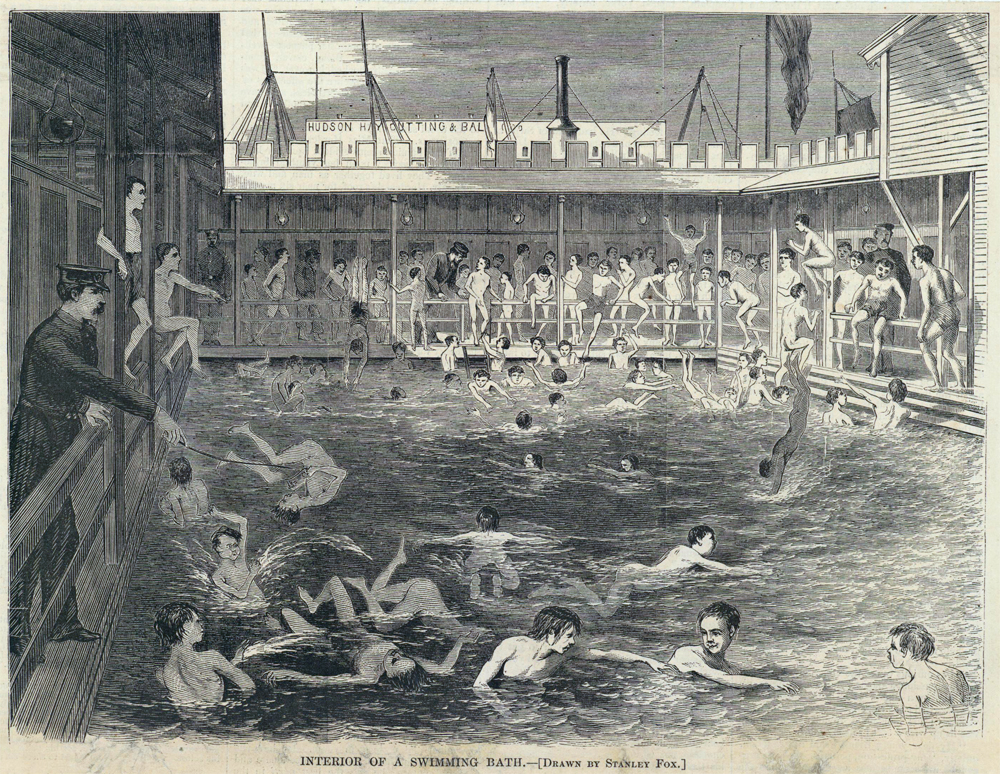
But the city’s objectives in opening public bath houses (starting in the 1880s) weren’t merely related to cleanliness. Most believed access to clean water promoted health and kept epidemics from spreading. This wasn’t strictly for the benefit of the poor, but for the wealthier classes who interacted with them in daily life.
From Gotham by Edwin G. Burrows & Mike Wallace: “[I]n the late 1880s, [German professor Simon] Baruch began a campaign stressing that baths, in addition to benefiting the poor and helping create “civic civilization” out of “urban barbarism,” were in the interest of “the better situated classes”: no longer unwashed, the employees, servants, laborers, and tradespeople next to whom they sat on crowded cars would not carry so many deadly germs. ”
Public baths also provided relief in hot summer months — air conditioning and affordable electric fans were decades away — and encouraged physical activity. The public bath, in effect, gave rise to the urban swimming pool movement, drawing children from dangerous piers and swimming holes and into carefully monitored (if incredibly crowded) water environments.
In 1888, New York installed several outdoor baths within the city, imposing 20 minute time limits on swimmers to keep the water clean. (No matter; adventurous children hopped from pool to pool to skirt the rules).
Public Bath #10 on the Hudson River
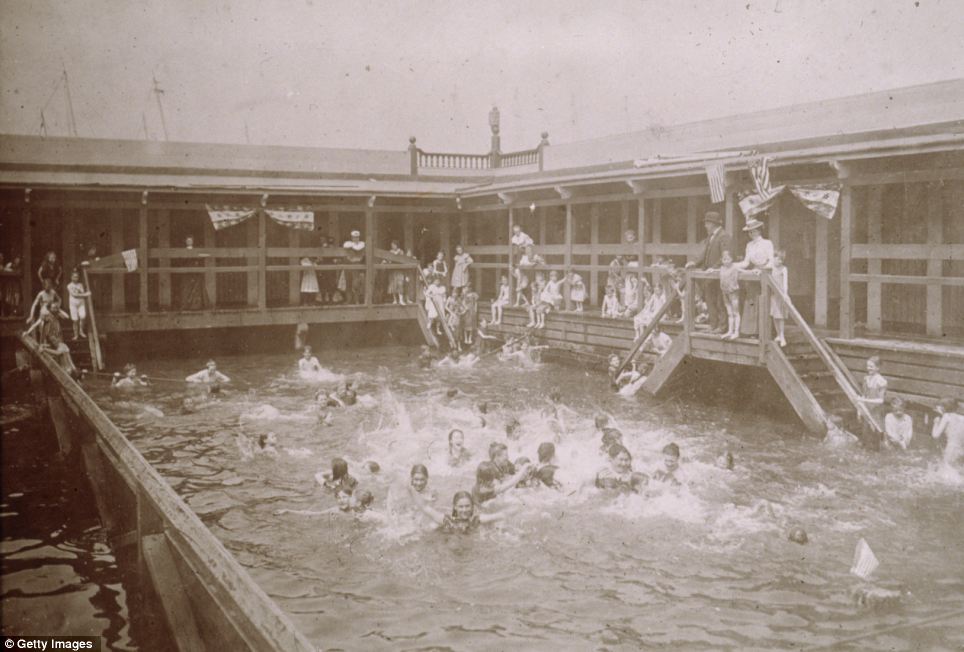
Three years later, a grand People’s Bath (at Grand Street and Centre Street) provided people with soap and towels for the modest admission of five cents.
In 1895, public bathing became a priority for Mayor William Strong who authorized a Sub-Committee on Baths and Lavatories which reported that “New York City was lagging far behind European and other American cities in the building of baths and urged that the city begin immediately to remedy the situation.” State government soon concurred, passing a mandatory bath law that year, “making the establishment of public baths mandatory for all first- and second-class cities in the state.” [source]
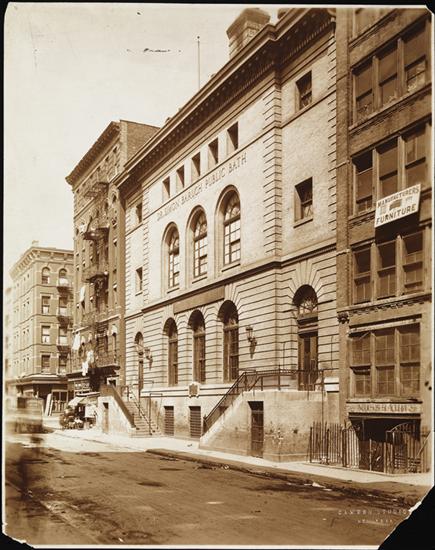
New public baths began opening by the new century, many in the Lower East Side; the first, Rivington Street Bath (pictured above), even had 91 showers and 10 bathtubs.
An advertisement for baths in 1935:
They’re mostly forgotten about today but a few remaining historical structures bear evidence of these important structures.
One such relic sits at Madison Street in the Lower East Side, within the La Guardia Houses development. (It’s listed in the above advertisement at 5 Rutgers Place.)
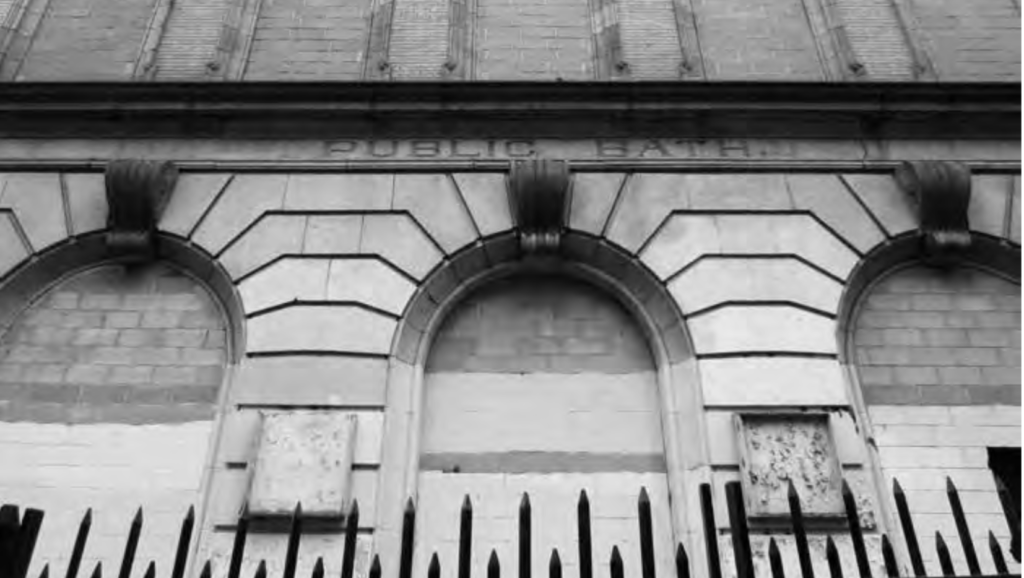
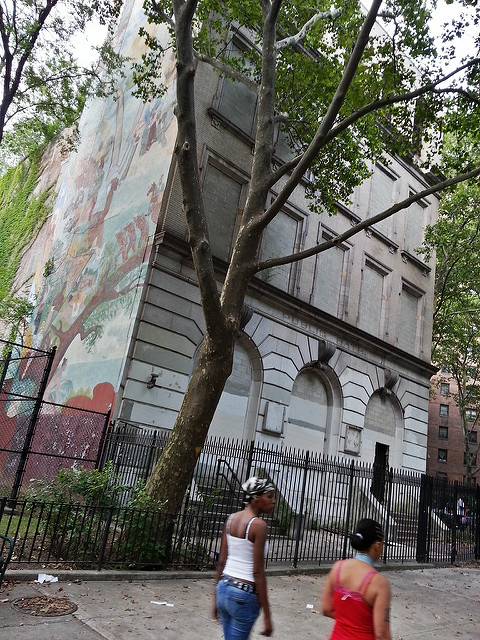
Nicknamed the Whitehouse, the bathhouse opened on December 23, 1909, and was one of thirteen public bath facilities in New York at that time. By the 1940s indoor plumbing had rendered the public bath obsolete, and so it was converted into a public swimming pool and gymnasium. Today it sits unused, like many others throughout the city, a ruin from another time.
Others have been rescued and serve new purposes such as the Milbank Memorial Bath at 325-327 East 38th Street (pictured below). Today the structure is the Indonesian Mission to the United Nations, but when it opened, it was one of the biggest bathhouses in the city, serving up to 3,000 people.
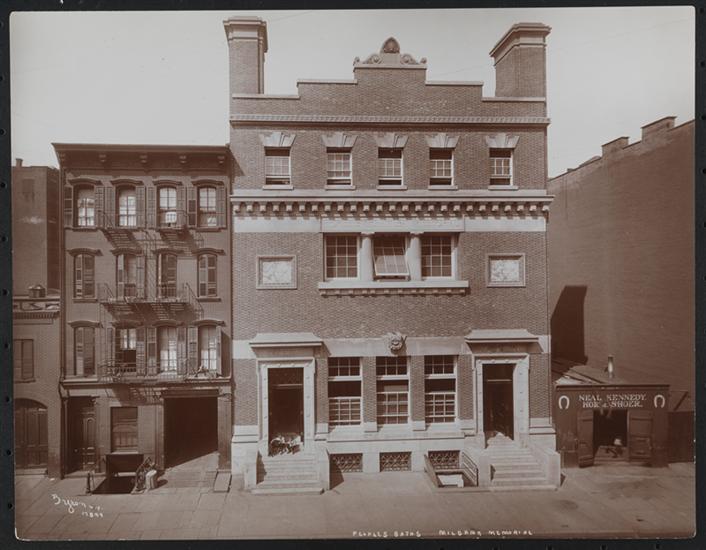
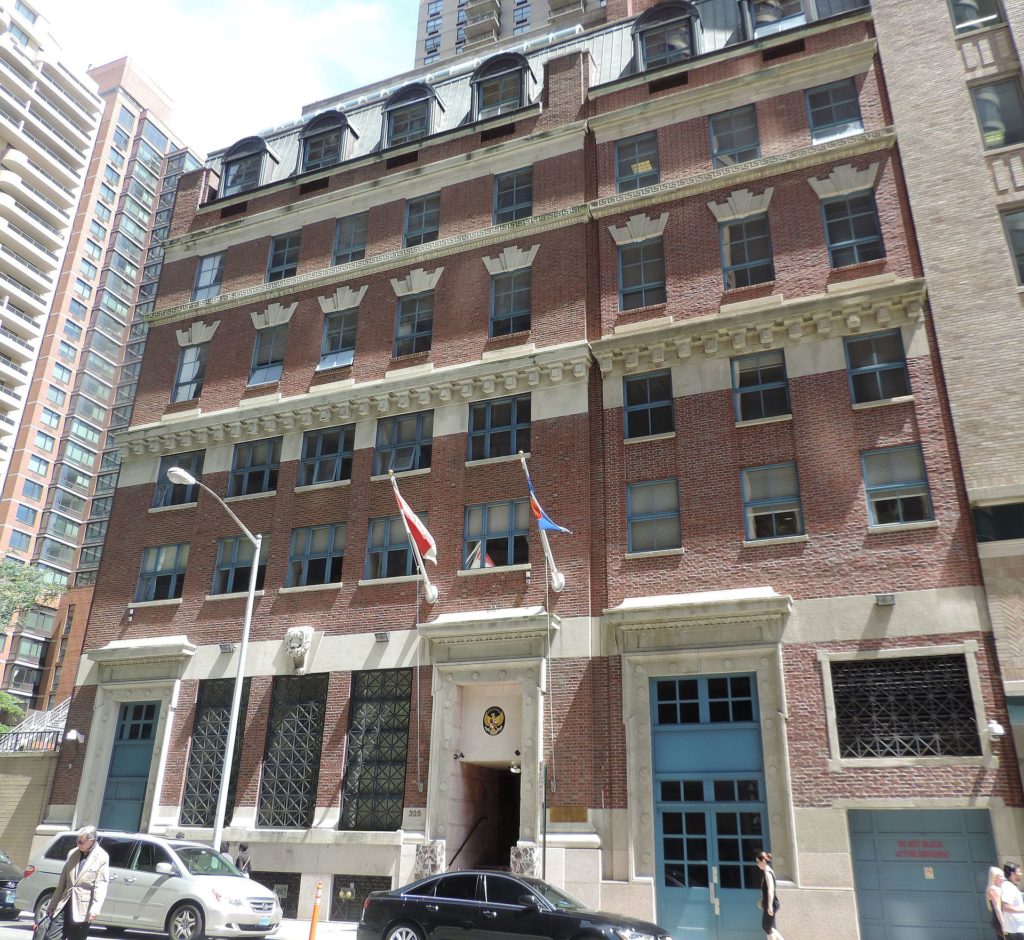
The grateful visitors of Milbank’s bath house:
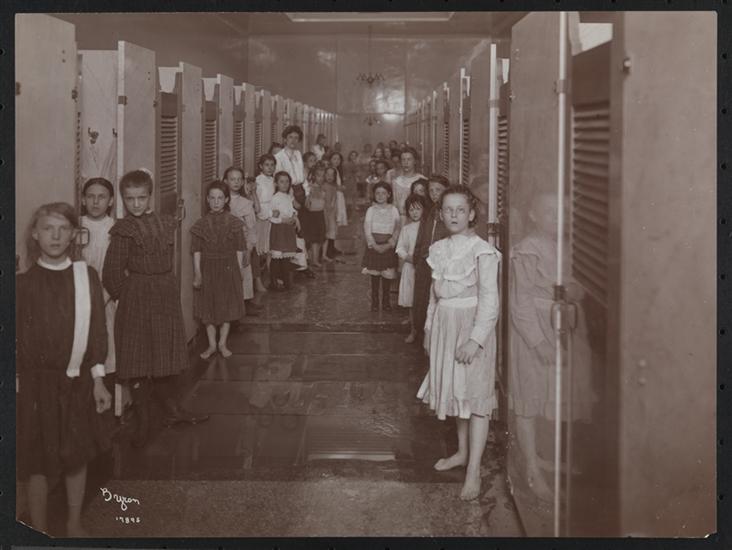
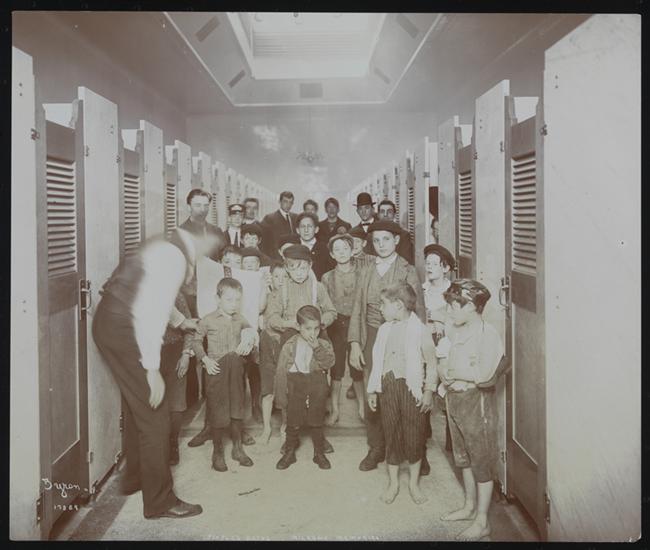
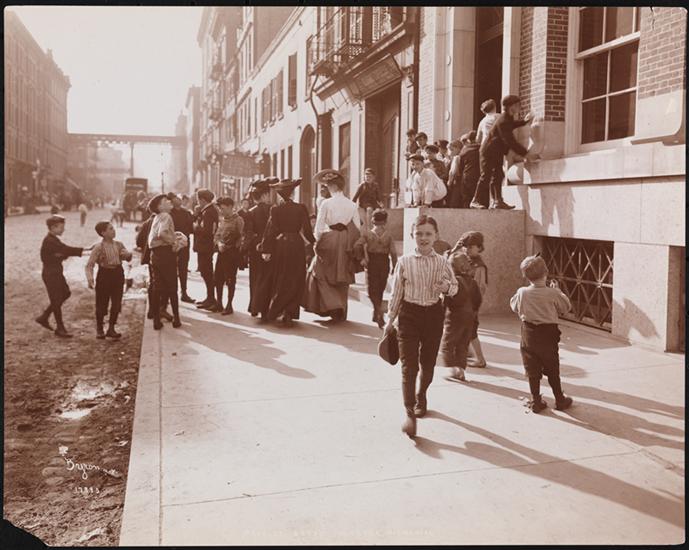
Perhaps the best known — and most beautiful — example of a public bath house standing in New York City today is the Asser Levy Public Bath in Kips Bay. (It’s also listed in the billboard image as 388 Avenue A.) Its unusual beauty is perhaps what saved it from demolition, and today it’s part of Asser Levy Recreation Center, serving in its original function — as a swimming pool for neighborhood children.
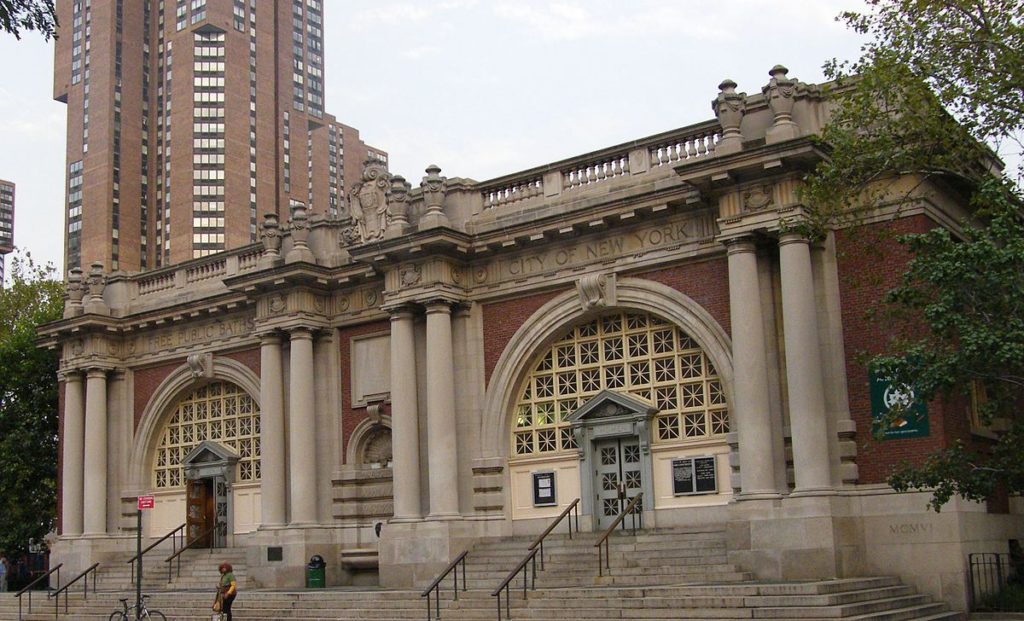

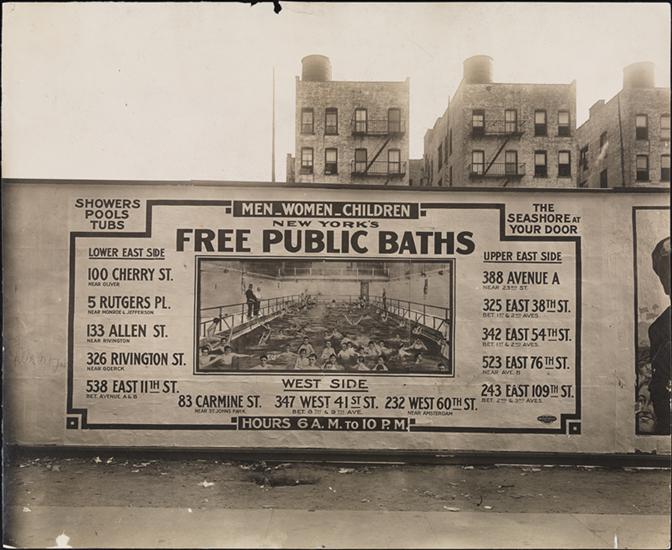
23 replies on “Scenes from New York’s public baths: How tenement dwellers got clean and cool”
[…] Scenes from NY’s Public Baths from The Bowery Boys […]
https://www.distilledhistory.com/bathhouse/
Toward the end of the 19th century, social reformers led a movement to improve the quality life of all Americans, not just the wealthy. At the center of this movement was a push to improve the living and working conditions for poor people living in urban slums. Since being dirty and being poor were seen as going hand in hand, promoting cleanliness became a part of that movement.
At the same time, scientists and doctors were figuring out that good personal hygiene could help prevent the spread of disease. This sentiment can be seen in a statement made by the New York Tenement House Committee in 1894:
“Cleanliness is the watchword of sanitary science and the keynote of the modern advice aseptic surgery. If it apply to the street, the yard, the cellar, the house and the environment of men it most certainly should apply to the individual.”
Already popular in Europe, the movement prompted a few American cities such as New York, Philadelphia, and Baltimore to build public bath houses in the early 1890’s. Encouraged by the initial success and high attendance rates, the public bath movement quickly spread to other American cities. In St. Louis, the progressive mayor Rolla Wells campaigned for several bath houses to be built throughout the city. Despite his support, it would be several years before St. Louis joined the movement. Forty American cities had operational public baths before St. Louis opened its first.
I wonder how often the water was changed in these public pools (bath tubs) or even if chlorine or other sanitizers were used.
Gonna take a wild guess and say — not often! Chlorine in pools only came along (I believe) in the 1910s or 1920s…..
I read on Wikipedia, “Every pool was drained, flushed and swept twice a week, prior to the two days set aside for ladies only, Mondays and Thursdays.” I don’t understand how thousands of people bathing in the same bathwater REDUCED disease.
Because the infectious disease knowledge was limited.
They also often required the boys and men to swim naked, up until the 1970s. Many pools were not coed at all.
I remember going with my dad when I was 6 or 7. All men and boys were naked swimming. I was fine with.. just remember the moment as so out of ordinary. Wish it was that way now.
It does seem rather incongruous. But then some of the bath houses actually mainly only had shower stalls, not communal bathing facilities, which would have been more sanitary in that respect then. (this was especially true for the bath houses that were located in tenement areas). The whole (relatively new) aesthetic of cleanliness that was being promoted at the time was easier for the rich and well-to-do middle classes to adhere to because they had their own bathtubs. Being able to bathe (even in a communal bath) at least provided for the mental health of the poor and working class people (if nothing else) and contributed to their general well-being. I guess sometimes all the kinks hadn’t been worked out of the system yet, however, or somethings hadn’t been taken into consideration, at any rate. Also the whole movement to build all these bath houses may have been based on supposedly altruistic motives, but according to the summation in “The Design Of Reform — The Public Bath Movement in America” by David Glassberg: “The baths resulted not just from the reformers’ compassion but also from their desire for control; they built baths not just to ameliorate the condition of the poor but also to help contain it. Reformers hoped that the baths would insure a relatively sanitary urban population until society enacted extensive housing reform. Instead of extending a soapy hand out to the poor, inviting them to share in a common civic life, the bathhouses’ design and experience suggest that the reformers’ foremost consideration was to prevent the contamination of the rest of society by crime, immorality and disease.”
Interesting article! I’m curious to know if there are any records (early phone books, etc.) that list the names and locations of NYC area bathhouses in the 1920s. I have an old photo of an ancestor wearing what looks like a “CH Keller’s Baths” swimsuit from around that time. Thanks!
Search Google and Google Images
Really neat. All these images are of, basically, swimming pools. Is there any evidence of more private facilities? I’m thinking of some sort of enclosed or semi-enclosed tub or shower. I feel like I’ve seem them but can’t think of any that weren’t medically-oriented for hydrotherapy (and expensive)
I believe the first two images under “The grateful visitors of Milbank’s bath house:” show the shower stalls that were available at that location.
[…] http://darkroom.baltimoresun.com/2016/10/148789/#12 https://www.boweryboyshistory.com/2018/03/scenes-new-yorks-public-baths-tenement-dwellers-got-clean-… […]
My mom grew up on east 11th street (between ave A and ave B)right down the street from the bathhouse.
She was born in 1920 and she and her family used the bathhouse.
I remember the old bath house in the Bronx,NY. It was closed in 1951 when I was a boy.Wished it was opened so I could cool down in the Bronx heat. It was not far from the PAL which had everything EXCEPT a pool to cool off in after a good baseball game.
Does anyone know what year the public bath house on Pacific Street, near Columbia Street in Brooklyn closed and was torn down, was it torn down to make room for the BQE? I have a Brooklyn Eagle postcard from 1909, that shows the building,
Any information would be greatly appreciated
My grandfather was a masseuse. He worked at the Luxor and then owned a Turkish bath hiuse. The pool was used for Jewish women to go get “dipped” after their menstrual cycle.
If you watch the excellent HBO Max series “The Alienist” (2 seasons, 2018), you get a real sense —extended throughout a number of episodes— of what a public bathhouse in 1890s New York City was like (note: avoid Season 1/Episode 9 if you can’t stomach scenes of blood and guts). BTW, the end credits for each episode unfortunately do not indicate where the scenes were filmed. But I’m still watching, so what must be a still existing bathhouse might be indicated after the final episode.
Do you know how the public bath house pools of the late 1800’s were drained? Do you know a source that explains that?
@aheather, the series was filmed in Hungary, and the bathhouse scenes were filmed at the Kiraly Bath in Budapest, one of a number of thermal baths built by the Turks in the 16th c. that are still very much in use today.
In the early 1950’s I was a teenage girl went with my friends to an old Harlem bath house in the winter because it was the only free indoor pool open to us. We also went to St. Mary’s in the Bronx. It was so massive I thought it was an armory but now think it was a converted bath house. There are several in the Bay Area, many in San Francisco. Some are still traditional bath houses while others have been converted to public indoor pools. I took my kids to several in the early 70,s as there were few indoor pools.
Were there public mirrors in the earliest public bathhouses (1850s-1880s). Is there a source describing these mirrors?